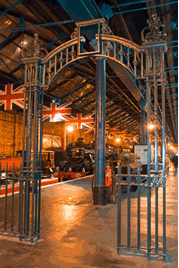 Read the peer reviews for this feature.
Read the peer reviews for this feature.
Download the graphs for this feature.
The symbolism of choosing the National Railway Museum as the venue for the launch of the National Infrastructure Commission (NIC) on October 30 reflected both the current levels of investment in the railway and one of the NIC’s three specific projects - to examine how the North’s needs can best be met.
The two other strands in the terms of reference are energy infrastructure and to examine the road, rail and underground needs of London. Chancellor George Osborne and NIC Chairman Andrew Adonis talked about the Commission’s role in overseeing the promised £100 billion investment in infrastructure by 2020, and Osborne announced that large investment projects would be at the heart of the November Autumn Statement and Spending Review.
But what is the background to the NIC, and how well conceived is its remit? Many who read the terms of reference might have been surprised at how thin they are - without their repetitiveness, they would have been even shorter, and they raise more questions than provide answers.
The idea was taken from Labour’s plans for an identically named NIC that were drawn up by Sir John Armitt, who is one of the seven commissioners on the NIC. Labour envisaged a more overarching role not confined to specific proposals or geographical areas, and its deliberations were to take account of a broader context. For example, it was to take into consideration population trends, modal integration, the environment and climate change.
Taking the North first, the NIC will work with the Department for Transport, Network Rail and Transport for the North, which will be producing an updated Northern Transport Strategy by Budget 2016. It is charged with identifying “options for long-term transport investment… that will improve connectivity between cities, form a single northern economy and drive economic growth”, looking particularly at east-west corridors.
The NIC will build on that, looking at gaps, the growth drivers and constraints, and ways to increase benefits and reduce costs, over a 20 to 30-year time frame. The recommendations will be stress-tested under three affordability scenarios, and the deadline for the report is Budget 2016.
In looking at the strategic options for London, the NIC will be working with Transport for London and NR on a blanker canvas, apart from Crossrail 2. The terms of reference are similar to those applied to the North, except for the gnomic injunction to “consider the potential impact of both Crossrail 2 and other strategic options for employment, productivity and housing supply in London and the South East”. Recommending the next steps from that cat’s cradle by Budget 2016 will be a challenge.
Funding will obviously be at the heart of the NIC’s conclusions. Osborne expects asset sales to fund part of the planned spending, but the options are certain to be constrained by the Charter for Budget Responsibility requiring the public finances to be in overall budget surplus by 2019/20. Given the almost monthly revisions to progress reports on that goal, one wonders how much value there is to stress-testing the NIC’s proposals for affordability over a 20 to 30-year period.
A unique criterion of the London evaluation is to consider “options for funding and financing in a way that minimises the taxpayer burden, and ensures those that benefit most bear a fair share of the cost”. Will that encourage ideas of wider road user charges? Will it factor in the colossal health costs of London’s traffic-induced pollution, or the costs of congestion?
Transport investment in the capital will arguably have a greater impact on the quality of life for its residents and workforce than any other government intervention. Yet there is nothing in the NIC’s terms of reference to focus investment on schemes that will encourage the use of the only sustainable mode capable of meeting the needs of a city with a population expected to top ten million within 15 years.
There are other unanswered questions:
- How does the NIC’s work dovetail with the Treasury’s National Infrastructure Plan (RailReview Q2-2015)?
- Will projects be determined by top-down decisions with limited consultation, or will the opinions of end users be canvassed?
- Will the NIC be delving into the myriad small-scale projects that can produce benefits out of all proportion to their cost: the passing loop on the Falmouth branch that transformed the service and generated a 208% passenger increase in ten years; the Todmorden curve; the incremental schemes to improve the Felixstowe-Nuneaton freight corridor?
On the same day as the Autumn Statement was delivered, the Bowe Review into the planning of Network Rail’s Enhancements Programme 2014-2019 was published. Dame Colette Bowe’s report highlighted the need for long-term visibility of an infrastructure programme if the supply chain was to overcome the capacity constraints (particularly in signalling and electrification) that had undermined progress with current enhancements. It also warned of the risks inherent in a lack of “whole system thinking” and failing to integrate infrastructure planning with rolling stock choices and franchising.
Passenger engagement
The Bowe Review also implied a challenge for the NIC consultation process by pointing out “the importance of passenger engagement in scheme selection” in infrastructure planning, and that “Route Utilisation Strategies were drawn up with input from local user groups, as well as Transport Focus and operators - passenger, freight and open access”. The limited time given for the NIC’s recommendations will make it difficult to adhere to these precepts.
The Autumn Statement and Spending Review on November 25 contained no surprises, although the £150 million funding for delivery of smart and integrated ticketing across rail, tram and bus services in the North was announced. Some £15.8 billion was earmarked for high-speed rail, and £20m was allocated to the New Stations Fund, mentioning a new station between Castle Cary and Taunton. Otherwise, the statement listed existing projects.
The railway cannot complain about the figures. Total rail spending including high speed in 2015-20 is budgeted at £50.3bn, compared with £22.6bn on roads, plus £0.5bn for the Local Sustainable Transport Fund. This implies a desire to move to a more sustainable balance and reduce carbon emissions, as does the commitment to freeze rail fare increases at no more than inflation (RPI) until 2020. This will do little more than moderate a widening gap in the costs for rail and road users. It has been government policy to make rail users pay a higher proportion of costs - the consequence has been a real-terms increase in rail fares of 63% between 1980 and 2014 compared with a fall of 14% in the cost of motoring, according to the Office for National Statistics.
The prospect of additional costs for the rail industry arose through the promise of “action to ensure that rail passengers have access to compensation when trains are more than a few minutes late”.
As for wider objectives, there is no sense either in the terms of reference for the NIC or in the Autumn Statement of a guiding mind, of any policy or vision underpinning spending, other than a drive for economic growth.
Climate change
Unlike Labour’s plans for the NIC, there is no mention of the environment or climate change. To plan new infrastructure without even recognising the economic and physical necessity for modal change and setting appropriate targets seems breathtakingly irresponsible.
Transport infrastructure development needs to be matched by a framework of complementary pricing policies to move towards genuinely sustainable outcomes.
Osborne described the NIC as “a statement from our generation that says: ‘we are going to think for the long term, we are going to plan for the future, we are going to lead the world’”.
Ignoring the fanciful hyperbole, the only way to plan for the future is to have a clear vision of how Britain needs to develop and what transport will look like 30 years hence.
As the architect Norman Foster says, infrastructure is about “investing not to solve the problems of today but to anticipate the issues of future generations”. If, as scientists warn and the UN sustainable development goals set out, the global economy needs to be decarbonised by 2050 to avoid unimaginable disruption and costs before the end of the century, infrastructure investment plans that take no account of this are not fit for purpose.
As the costs and lifestyle-disrupting aspects of climate change become more apparent by the year, it should be unthinkable for policies in all spheres of the public realm not to be subordinated to the goal of decarbonisation and maintenance of a stable biosphere. Unless the NIC is given a framework with clear societal as well as economic objectives, it may be counter-productive in its impact.
Economic growth and sustainability are not mutually exclusive. Britain still needs to build a consensus around a strategy for that long-lost Holy Grail - a rigorously integrated transport policy.
Read the peer reviews for this feature.
Download the graphs for this feature.
 Peer review: Ailie MacAdam
Peer review: Ailie MacAdam
Managing Director of infrastructure – Europe and Africa, Bechtel
The creation of a National Infrastructure Commission is something that the industry and I have been waiting for. It’s well-known that long-term planning is the basis for the successful delivery of infrastructure projects, even though short and medium-term issues such as budgets, interfaces, politics and other external pressures may still have an impact.
Every time I walk through St Pancras International station, a project I was fortunate enough to work on when I led the team that delivered High Speed 1 ten years ago, I think of the old, dingy, (let’s face it) worst station on Euston Road that sat there 15 years ago, seemingly with its best days long behind it. Government commitment to HS1 and a new gateway to mainland Europe gave the certainty and the funding for the transformative, inspirational building we know and love today. I am hugely proud of Crossrail (which I will come onto in a moment), and I enjoyed every minute of the London Olympics, but before both of those came St Pancras. To me, that and HS1 were the first iconic UK infrastructure projects in a long time, demonstrating to politicians and the travelling public that this country - which brought the world the railways - hadn’t forgotten how to be ambitious with our infrastructure. The confidence it brought to the railway should not be forgotten either.
Crossrail, the largest infrastructure project in Europe, has been described as a “textbook example of how to get things right”. In my role as project director (and Bechtel’s as delivery partner) on Crossrail, it was clear that providing effective programme management would be vital to not just keeping the project on time and to budget, but also to communicating with the numerous stakeholders involved on a project of this scale.
While Crossrail still has some way to go before it is complete, it wouldn’t have got this far without political champions from the outset, a strong client, continued support from the City and the community, and a vision of how the project would fit into a wider, integrated transport scheme. Successive London Mayors, Prime Ministers and Chancellors held firm in the face of budgetary pressures, knowing that the benefits of the project would come after they left office while the disruption and cost was incurred on their watches. This is the root of the infrastructure conundrum: National and local politicians make the investment and take the upheaval today, and their successors (perhaps of another political hue) get to cut the opening ribbon and keep the country moving years and decades later.
The National Infrastructure Commission, with its team of seasoned industry professionals and visionary politicians, has an opportunity to provide an overarching, constant and long-term perspective. They can be the infrastructure champion - joining up the needs, ambition and business cases into the nationwide plan that has been lacking in the past.
The trans-Pennine corridor and Crossrail 2 will benefit from this new holistic approach, and a longer-term strategy will provide clarity and certainty for the industry itself, enabling contractors, the supply chain, programme managers, manufacturers and design firms to plan accordingly and invest in the people, innovation and resources they need for the future. And in so doing, benefit the UK economy.
I hope the NIC will look at the lessons of the past (good and bad), and listen to people who can share their experience and knowledge across the spectrum of infrastructure projects, effective delivery structures, ethical procurement and innovation. Across the country there is a committed, skilled and increasingly diverse workforce quietly getting on with their jobs to maintain and upgrade our country’s infrastructure. We can collectively learn from their achievements to successfully deliver the projects of tomorrow to support and inspire future generations.
 Peer review: Richard Threlfall
Peer review: Richard Threlfall
UK Head of Infrastructure, Building and Construction, KPMG
Two misconceptions underpin this article. The first is that the National Infrastructure Commission is only focused on three particular topics, to be solved by next March. The second is that the Government sees infrastructure only in terms of driving economic growth, and cares toffee about sustainability.
The National Infrastructure Commission’s remit is a broad and long-term one, very similar to the one proposed by Sir John Armitt for the Labour Party - indeed, remarkably similar. Just as the Chancellor performed a spectacular U-turn at the Autumn Statement on his proposed cuts to tax credits, so a few weeks earlier he had reversed what had been the Government’s total antipathy to having a long-term vision for infrastructure, by announcing that he had just appointed Lord Andrew Adonis to do that very job.
Bear in mind that not only is Sir John Armitt now one of the seven National Infrastructure Commissioners, but Andrew Adonis was one of the small group who worked with John to develop his proposals. So you might reasonably expect some continuity of thinking.
The confusion as to the role of the NIC exists because in today’s world, where few people have any patience, results have to be delivered fast. The one big criticism of the Armitt proposal was that it would take at least five years to deliver anything. The risk was that the NIC would disappear into the library of the House of Commons for years, and eventually emerge with a 10,000-page thesis on the future of Britain, only to get abolished a few days later following a change of government.
To avoid this fate, it was agreed that the NIC had to be able to show within its first six months that it mattered. It would therefore need to take on some seriously chunky questions. However, in my view, it has probably taken on too much. Connectivity across the Northern Powerhouse, London transport, and energy supply and demand are three really big questions to address in what is now only four months (or less, by the time you take out Christmas and the need to get buy-in to the proposed answers from the Chancellor and myriad other stakeholders before the Budget). But at least they give the NIC a sense of real urgency and purpose.
Of these three topics, the hardest is not London, it’s the North. London is a big topic, but much of the thinking (and concrete proposals) already exist - the NIC can fulfil its remit by a critical review of the London Infrastructure Plan and the proposals for Crossrail 2.
The North is much harder, because no proposal exists. Transport for the North has only recently been created – David Brown was appointed as chief executive only a few weeks ago, and John Cridland took up his post as chairman at the end of November. The cities of the North are only just starting to work out how they should talk to each other, let alone sign off on a 30-year investment plan that the Chancellor can announce early next year. So I would temper expectations about what can be achieved - I expect the NIC will set out some principles and options and suggestions for the governance necessary to develop those into solutions in due course.
The energy remit is there to balance what might otherwise appear to be an entirely transport-dominated agenda. It will apply some broad brush strokes to very difficult questions around the extent to which smart meters and retrofit can moderate energy demand, and batteries and interconnectors can boost supply.
But to return to where I started - these three topics are a sideshow. They are three immediate deliverables to prove a point. The real value of the NIC is its long-term remit. That will be further defined in legislation in due course.
It will look at the long-term infrastructure challenge holistically, as Anthony would like. It will consider a range of scenarios for population growth, climate change and technological developments, and it will advocate the infrastructure investments likely to deliver the best outcome for the country in the long-run.
In doing so, the NIC will need to grapple with what constitutes that best outcome. Anthony says that all policies should be “subordinated to the goal of decarbonisation”, but that is neither realistic nor desirable. There are multiple potential objectives that a rational society might seek, and these will often be interdependent. I don’t consider it unreasonable that the Government sets economic growth as a headline objective, because through economic growth will come the ability to invest in decarbonisation, in education, healthcare, recreational facilities, and whatever else we want. The Government is explicit in recognising these links - the whole of the opening of the Chancellor’s Autumn Statement speech was on this theme, ending with the statement “nothing is possible without the foundations of a strong economy”.
I agree.
And infrastructure is a key ingredient of that strong economy. Our infrastructure investments are for the long term, and if we make the right decisions our investments yield a return by increasing the country’s economic growth. The really difficult question is how much of today’s wealth do we invest for the benefit of our grandchildren. I am not sure if the NIC can reasonably be expected to answer that without some political steer.
Then there is the question of how to decide which infrastructure projects to prioritise. I agree with Anthony that this prioritisation needs to be underpinned by a social as well as an economic assessment framework – one that can cope with comparing not just one road scheme with another, but a road scheme with a new garden city or a new wind farm. And none of these investments exists in isolation. The new garden city needs new roads and sustainable power, as well as schools, hospitals, sewers and parks. It will demand not just an integrated transport policy, but an integrated infrastructure policy. But the inter-dependencies are of mind-boggling complexity - hence two of the NIC’s commissioners are distinguished economists.
The final big challenge for the NIC is the pace of technology change. For example, what assumptions should the NIC make about the development of driverless vehicles and their impact on our society? In that future world, I think no one will own cars. We won’t need garages. Taxis will no longer exist. Children, the elderly and disabled will be able to go anywhere, at any time. Road capacity will double (or triple) overnight. The distinction between vehicles and trains will gradually disappear. And goods will be delivered by drones. How is the NIC to deal with all this uncertainty? The only feasible approach will be to develop a series of scenarios and to favour infrastructure that is more flexible and adaptable.
So the NIC will, of necessity, think big and long-term. It will pose the questions and accumulate the evidence. It won’t be able to predict the future - but it could create the basis for better decision-making, increasing the chances that our politicians make the right choices.
This is a revolution in how we think about our country and its future.
 Peer review: Cliff Perry
Peer review: Cliff Perry
Former chairman of IMechE
Anthony hits the button with his comments, taking a broadly supportive view but pointing out where the challenges lie. I believe most railway folk will welcome the creation of the National Infrastructure Commission as an opportunity to strengthen common sense, rather than politics, in the way we make important decisions. They will also warm to the appointment of Lord Adonis. So a great start, and the initial remit hits the right targets: transport for both London and the Northern Powerhouse, and Energy.
There are, however, several limitations, as Anthony points out. We can hope that these will be addressed by further work on the Terms of Reference as the Commission delivers and moves on.
Starting with timescale: to make the scale of decisions called for in the North (using a consultative and robust method) before the budget in 2016 means that the Commission is starting ten years too late, and will be heavily influenced by the Transport for the North work and suggestions. Similarly for London, the early Commission output will be heavily based on the TfL model and priorities.
The weakness of relying so heavily on bodies with relatively recent devolved responsibilities is also highlighted by Anthony’s comment about the lack of the “Holy Grail” of a National Transport Strategy. Devolving responsibility in the absence of an overall framework is a high-risk approach likely to lead to sub-optimisation at best and unworkability where we really get it wrong.
Take, for example, the matter of freight for the North, to fuel its industry and serve its population. Unless something is done to influence the market in a significant way, it seems likely that most of this freight will arrive sub-optimally, and need to find its way north through a crowded South East. One specific (Imports from India) was highlighted by the Westminster Energy, Environment and Transport Forum 2015, and is illustrated below.
Planned economic and population growth is creating a substantial capacity challenge for our transport network. London’s population is expected to rise from its present 8.5 million to 11.5 million by 2030, with the UK moving from 62 million to more than 70 million at the same time. These volumes then take our systems into uncharted territories, and may call for a different approach. For example, in the same way that traffic growth has made electrification viable on new routes, so we may need to challenge our current use of mixed traffic railways, and choose to build new dedicated freight routes as well as the planned new high-speed passenger lines.
North American freight productivity improvement has been delivered by intermodal traffic on very long trains with double-stacked containers - highly efficient, but totally incompatible with our current infrastructure or mixed traffic operation. But the development of a National Transport Strategy would seriously consider such options, and the NIC could react accordingly.
It is reasonable to expect a National Commission to have transport planning that is genuinely multi-modal, playing to the strength of each mode. Our access to sea-borne freight is vital for an island dependent on global trade, and longer sea crossings have significant volume potential.
Rail is good at bulk movements (freight and passenger) from node to node; road is vital for low-density distributive tasks, but less competitive over longer distances; air has a niche for high-value, low-density and perishable goods, and long journeys. Understanding the optimum efficiency solutions by mode and traffic will allow coherent analysis of the routeing and facilities required, guiding investment and project design. This is a fundamentally different approach from our current independent planning for ports, regions, roads and rail. We need to decide what our railways are really there for, then make sure they are fit for purpose.
Our dash for diesel and the VW scandal has highlighted the air quality debate. However, even the awareness that road traffic is the major contributor to approximately 29,000 pollution-related deaths in the UK (in addition to its 3,000 accident deaths) is only one specific example of the fact that we have no policy to charge users for the external costs of their activity. Anthony rightly draws attention to this anomaly - properly resolved, it would significantly favour rail. This makes the lack of reference to the environment seriously worrying in the NIC remit.
Also missing is any reference to resilience of transport infrastructure in the face of extreme weather events, and the ability to keep end-to-end capability even though one route may be blocked by event, by maintenance, or by investment projects.
Consultation must also be wide enough to make 30-year decisions resilient to changes in technology. Flexibility in ticketing may bring a significant lowering of the barriers to public transport use, while autonomous vehicles on our roads and the “Platooning” of lorries on motorways may transform perceptions. Basic planning assumptions on the shape of future technology will need to be made and the appropriate infrastructure provided. ‘Intelligent Mobility’ and the ‘Digital Railway’ are concepts that need to be defined, developed and harnessed to deliver better places to work and live in our crowded island.
In summary, the challenges for the NIC are huge, but recognising the need to do something different is the first step away from insanity.

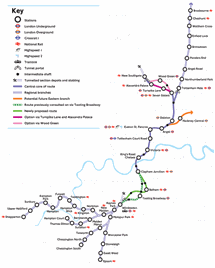
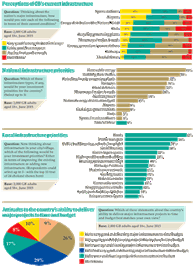
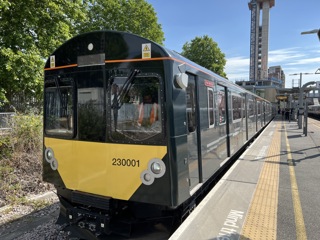
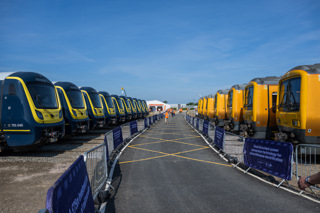
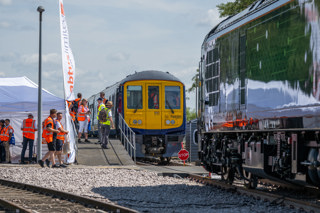













Login to comment
Comments
No comments have been made yet.